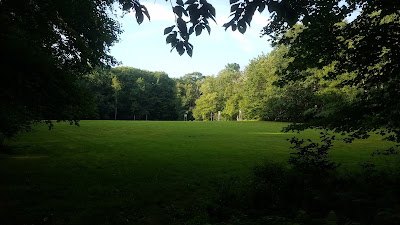Last evening was particularly nice for this time of year - warm, but not too hot. It was a little humid, but no rain in the area. It was the exception to the rule this summer, which has been particularly rainy so far.
One of the roads where I ride tends to be a hotspot for pedestrian traffic mixing with cars and trucks. It's not a busy road as a city street would be, but it's a small, lakeside road where drivers, walkers, runners, and bikers all tend to interact.
That means sharing the road with others, some in cars and some on foot. Sharing with cars and trucks is not so much an option as it is imposed on you. The cars and trucks generally control the road by virtue of their size and speed. Some drivers are more reasonable than others...
Pedestrians are another matter. This particular road is often used by a local running and triathlon club for training. They train on the road probably twice a month, or every two weeks. The members generally adhere to the usual rules of the road: run/walk against traffic, bike with traffic, wear reflective clothing, stay to the side of the road, etc.
So when you come upon a pedestrian, and at the same time have a car approaching, my advice is to be very deliberate and very obvious in what you are doing. If you are working out into the lane a bit to avoid the pedestrian, make it obvious that you're doing that. Don't swerve in front of a vehicle, but do get out into the lane and show that you are there. If you have to look at the driver or signal what you are doing, then do it. Where you get into trouble is if you take half measures and make it seem like you're going to let the car pass, then swerve in front of the car. That's asking for trouble. It's better to seem a little obnoxious than to confuse people and get hit.
And I recommend wearing a helmet, as usual. Remember too that on a vintage bike, your brakes may not be as good as a modern one. Keep your speed reasonable and don't go blazing into the lane such that a car has no time to react. If a driver becomes aggressive, let him or her go, don't confront the person, or deliberately swerve in front, or challenge him to force past you. It's better to just let jerks go by than to get hit. If you have to fire off a few coarse words, do it, but don't get into a fight or an accident. It's better to let it all go by than dwell on it. Don't let it ruin your ride.
Pedestrians can be another matter. Some pedestrians are actually "aggressive" in their own way. They'll walk 2 or even 3 wide, blocking half the road. Again, if you have fire off a salty word or two, do it, but don't get into a fight or hit anyone. It's not worth it.
These observations apply to the usual, somewhat narrow, two-lane country road. We all have to share these roads with others, some in different circumstances. Be sensible and don't let it bother you.
And if things go really bad - a car bumping you or brushing you. Don't be afraid to call the police. By all means, use 911 if it is an emergency situation, but use the non-emergency line if you need to report repeat offenders who are aggressive drivers. If you ride the same roads at the same time each day, you'll start to spot the "bad apples". Look up your state's passing requirements for cars. In my state, it's three feet of clearance. I can tell you most people give it to me, but some just fly by close without moving over for the bicycle. Safety should come first.








